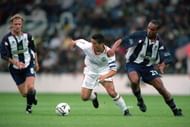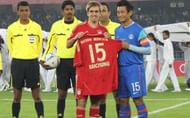The road to being the Indian football icon wasn’t smooth for Bhaichung Bhutia but at times he made it look easy. In a career spanning almost two decades, Bhaichung produced memorable displays for both club and country and on most occasions it was done in a very special way.
He created history several times and broke numerous records but 16 years ago on this date, he achieved something that may not be repeated by an Indian player and even if it is emulated, it won’t have the same classy touch.
On July 13 1997, a 21-year-old from Sikkim ensured himself a place in the famous old Kolkata derby history books by becoming the first player to score a hattrick in this marquee fixture. The treble was achieved in the colours of East Bengal with the red-and-gold brigade beating arch-rivals Mohun Bagan 4-1.
But this was not just another derby between the fierce rivals. It was the semi-finals of the Federation Cup and the Salt Lake Stadium had a record attendance of more than 131,000. The buildup to any derby is always intense but this one seemed to have no holds barred with then-Mohun Bagan coach Amal Dutta’s ‘diamond’ system catching the attention of the local language media in particular.
The atmosphere at the game was simply electrifying and in the eyes of most experienced heads of the Kolkata maidan such a setting before and during the game is unlikely to be repeated in any other Indian club football fixture ever.
Speaking to Sportskeeda, reputed sports journalist Dhiman Sarkar of the Hindustan Times recalled the build-up to the game giving some great insights.
“The build-up to this game wasn’t anything like you would usually associate with a Kolkata derby. At least not over the past 25 years. A large part of the reason was Mohun Bagan coach Amal Dutta employing the diamond formation. The idea may have been as old as the hills in football’s more developed countries but the media, particularly the Bengali newspapers (there was little or no 24X7 local news channels then) played it up using graphical representation to explain how Mohun Bagan would play.
“Moreover, Mohun Bagan had begun the Federation Cup with a bang and put in six goals past Churchill Brothers who were then coached by the astute Scot Danny McLean. Dutta’s deliberately slanderous pronouncements about East Bengal players (Chung-Chung for Bhaichung, Omlette for Sammy Omollo) further fuelled the expectation around this semi-final,” Sarkar, who covered this historic match, told Sportskeeda.
Clearly, Dutta’s pre-match comments added to the excitement and anticipation of this derby but what were the expectations from Bhaichung?
By then, the Sikkimese Sniper was no longer just the boy wonder of Indian football but already one of the best players, having won the AIFF Player of the Year Award in 1995 as a teenager and inspired JCT to the National Football League (NFL) title in the inaugural season (1996-97).
“Bhaichung by then had shown he’s made of a different mould. As a teenager at East Bengal, he would carry bottled water to the club. This, at a time when established India players would think nothing of drinking from a tap at the club. By the time this match happened, Bhutia had helped Bengal to a hattrick of Santosh Trophy titles and his transfer to JCT, who in the 1996-97 season built a star-studded team, was one of the most talked about things in Indian football.
“And he didn’t shirk from speaking his mind. That a player barely out of his teens could actually spurn East Bengal didn’t go down well with their officials. But in wooing Bhaichuing back next season, East Bengal showed how important he had become to Indian football by then. And he was only 21 then,” Sarkar recalled.
Like Mohun Bagan, East Bengal also enjoyed a comfortable win in the quarter-finals, a 4-0 success over fellow Kolkata outfit Mohammedan Sporting. But all eyes were on Amal Dutta’s Mohun Bagan and their diamond system.
The strategy might have worked against Churchill Brothers but getting it right against the arch-rivals in a pressure game was the real challenge.
Bhaichung himself recalls that Mohun Bagan were the clear favourites: “The hype surrounding the game was immense both among the media and the fans. We were undoubtedly the underdogs because Mohun Bagan were on great form and playing some good football so it gave me and my teammates great satisfaction to eventually win the game.”
East Bengal went in front in the 25th minute through Nazimul Haque with Bhaichung playing his part after a corner from Somatai Saiza but Mohun Bagan were very much in the contest going into the half-time break. However the second half belonged to the man wearing the no.15 red-and-gold shirt, Bhaichung, as he exposed the weaknesses in the diamond system with a hattrick thanks to some quality finishing.
The first of those was a towering header from another Somatai Saiza corner and the other two came from counter attacks with Bhaichung once again proving that there is no better finisher than him in Indian football.
Nigerian Chima Okorie’s consolation goal for Mohun Bagan might have been the best goal of the game but it mattered little as Bhaichung enhanced his reputation with a match winning performance in the biggest fixture of Indian football.
“After the hattrick, possibly the first in the Kolkata derby in independent India, he became East Bengal’s most enduring icon of recent times. In front of a record 131,000 crowd, Bhutia had dismantled Mohun Bagan, leaving them gobsmacked with incredible opportunism and finishing. He has always said he found the roar as players emerge from the tunnel at the Salt Lake stadium hugely motivating. That evening he had showed that the bigger the stage, the better he is spurred to play,” Sarkar stated.
The Indian Express used the headline ‘Bhutia’s barrage batters Bagan’ and rightly so. It was the perfect response from the Sikkimese striker to Dutta’s pre-match taunts. But what was even more fascinating was the way Bhaichung carried himself and spoke after the match.
Naturally, back then Bhaichung didn’t completely realise what he had achieved but post-match he exhibited a maturity and professionalism that was unimaginable from any young Indian sportsperson during those times considering the limited media exposure.
Throwing light on the same, Sarkar revealed, “For me, what stood out even more than Bhaichung’s performance – Chima Okorie who scored that match’s best goal was effusive in his praise of Bhutia soon after – was the calm with which Bhutia ripped into Dutta after the game. He spoke to the media in the showers of East Bengal’s dressing room, so chaotic was the scene inside that Bhutia took everybody into the bathing area.
“Sitting there, still sweaty, Bhutia said it was extremely disappointing that a man older than his father and a respected coach had stooped so low. I don’t remember if Dutta was ever ripped into thus. That evening Bhutia showed he wasn’t just electric on the field.”
The anecdote above shows why Bhaichung became what he is today and the player has always believed that one match doesn’t make or break a career.
“It was a great feeling to score a hattrick on such a big occasion and it’s true that it gave me a lot of media attention but I had to work even harder after that. For me you are only as good as your last game so I had to start from scratch again from the next match,” said India’s most capped player.
From the humble beginnings of Sikkim to being India captain and Indian football icon, it has been a long and yet successful journey for the Padma Shree Awardee. July 13 1997 would be remembered as the day when he took a historic leap towards greatness and in his own ‘Bhaichung-esque’ way.


